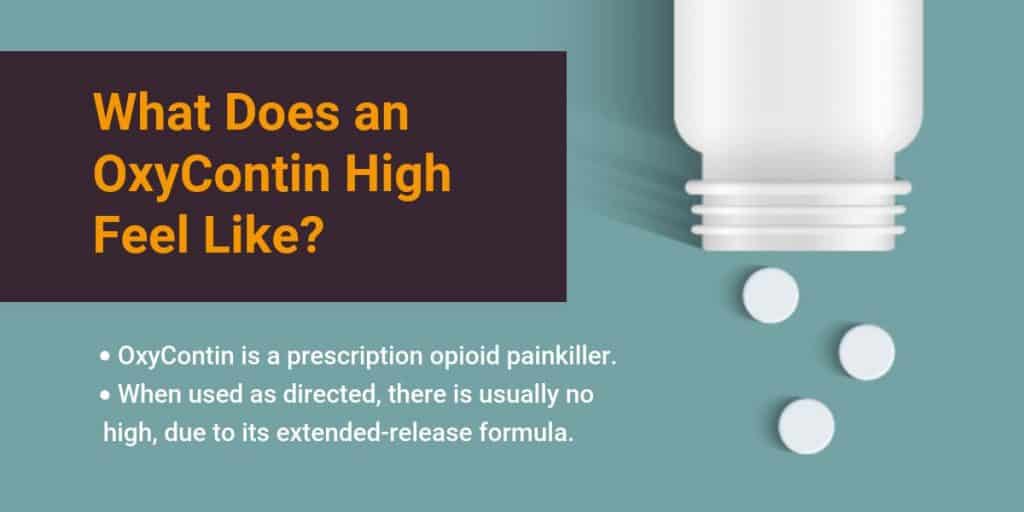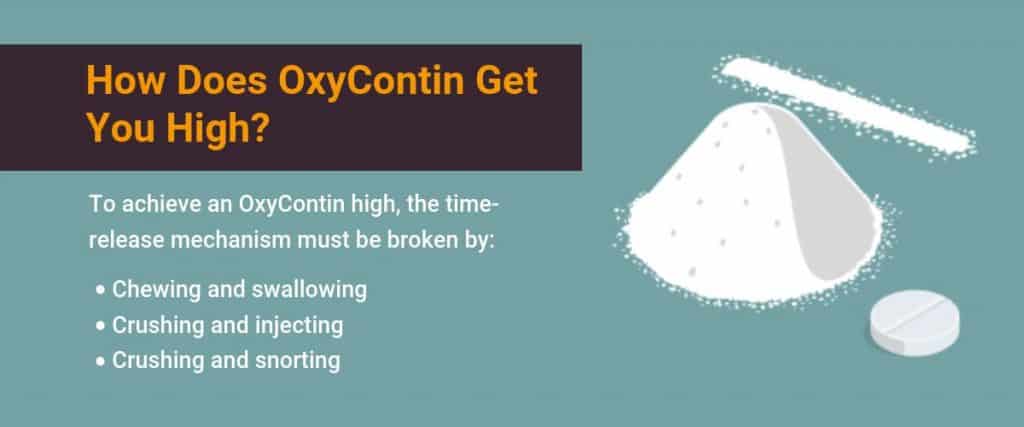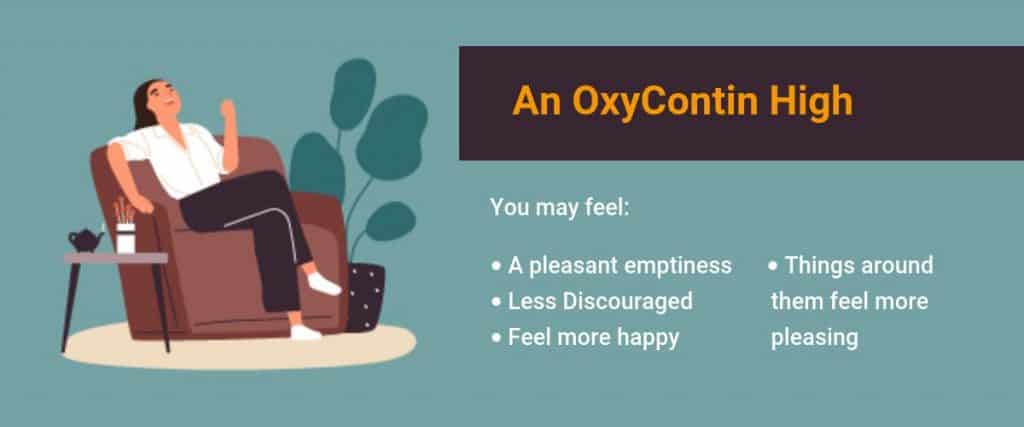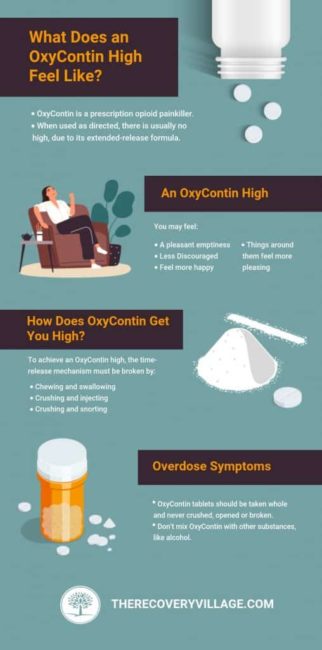OxyContin is a long-acting formulation of the drug oxycodone. Oxycodone is an opioid used to treat pain, but taking too much can cause a high that can lead to abuse and addiction.
OxyContin is a slow- or time-release formulation of the prescription pain medicine oxycodone. OxyContin will slowly release for 12 hours to help ease chronic pain. It was developed for people who need around-the-clock pain relief.
Since the effects of most opioids, such as Percocet or Endocet, last between two to six hours, the long duration is what makes OxyContin unique when compared with other opioids. OxyContin is very effective at treating chronic pain, but its long-acting formulation makes it easy to abuse.
But what does OxyContin (oxycodone) feel like, and why is the feeling so addictive?

How Does OxyContin Get You High?
If someone takes OxyContin as directed for pain, there is usually no high, due to its extended-release function. People with severe pain may feel high the first time using an opioid, but the feeling of the Oxy high quickly fades.
However, OxyContin can generate a high if it is abused. OxyContin changes how the brain processes pain. When people take OxyContin in high doses or outside the directions of their prescription, they experience a high marked by euphoria or a sense of well-being.

OxyContin tablets should be taken whole and never crushed, opened or broken. An OxyContin high is comparable to a heroin high because the drugs work in the same way. However, to get high from OxyContin, a person has to break the time-release mechanism by:
The Risks of Getting High on OxyContin
The first experience of taking OxyContin will probably be more pleasant than any other time a person uses the drug. When someone tries to replicate that first time, the process is commonly referred to as “chasing the high.” Most people report they never feel as good as the first time they experienced the high.

People may attempt to prolong their high by mixing the feeling of oxycodone with other substances like alcohol. When someone mixes Oxycontin and alcohol together, they feel a pleasurable high, but the mixture is more dangerous than either drug is on its own.
Combining alcohol with prescription opiates can result in slowed or arrested breathing, lowered pulse and blood pressure, unconsciousness, coma, and even death. Signs of an opioid overdose include:
- Unconsciousness
- Nearly imperceptible pupils
- Hypoventilation
Drug overdose can be fatal. If you suspect someone is experiencing an overdose, call 911 immediately. Do NOT be afraid to seek help. If you do not have access to a phone contact Web Poison Control Services for online assistance.
What Do Opioid Highs Like Oxycodone Feel Like?
Some studies found trends among people who use opioids like oxycodone for the first time regarding whether they developed an addiction. A 2011 study identified a group of people who became addicted to opioids after using them first for chronic pain. Researchers gave the subjects a questionnaire and asked how they felt while on opioids. People in the study may not have been using OxyContin or oxycodone, but all opioids generally provide individuals with the same, euphoric experience.
During their first opioid high, the people agreed that they felt:
- A pleasant emptiness
- Less discouraged than usual
- More content, but they were afraid to lose that feeling
- As if something pleasant just happened
- They felt happy all the time
- Things around them felt more pleasing
Such feelings can easily cause people to desire more of the drug. Taking more of the drug than prescribed is abuse, which can quickly lead to addiction developing.
Get the Help You Or Your Loved One Needs
If you or a loved one are using Oxycontin to get high or struggling with an opioid addiction, help is available. Contact us at The Recovery Village. Our representatives are ready to help guide you to the best treatment option. You deserve a healthier future. Reach out today.


American Psychiatric Association. “Diagnostic and Statistical Manual of Men[…]Disorders : DSM-5.” Print, 2013. Accessed May 30, 2019.
Bieber, Corey M., et al. “Retrospective Accounts of Initial Subjec[…] Case-Control Study.” Experimental and Clinical Psychopharmacology, 2008. Accessed May 30, 2019.
CAMH. “OxyContin: Straight Talk.” Centre for Addiction and Mental Health, 2006. Accessed October 29, 2021.
Food and Drug Administration. “Medication Guide OXYCONTIN.” 2015. Accessed May 30, 2019.
MedlinePlus. “Opiate and Opioid Withdrawal: MedlinePlu[…]edical Encyclopedia.” 2016. Accessed June 7, 2019.
National Association of Boards of Pharmacy. “Rates of Prescription Opioid and Heroin […] Boards of Pharmacy.” 2016. Accessed May 30, 2019.
UHS.UMich.edu. “The Effects of Combining Alcohol with Other Drugs.” 2021. Accessed October 29, 2021.
The Recovery Village aims to improve the quality of life for people struggling with substance use or mental health disorder with fact-based content about the nature of behavioral health conditions, treatment options and their related outcomes. We publish material that is researched, cited, edited and reviewed by licensed medical professionals. The information we provide is not intended to be a substitute for professional medical advice, diagnosis or treatment. It should not be used in place of the advice of your physician or other qualified healthcare providers.
